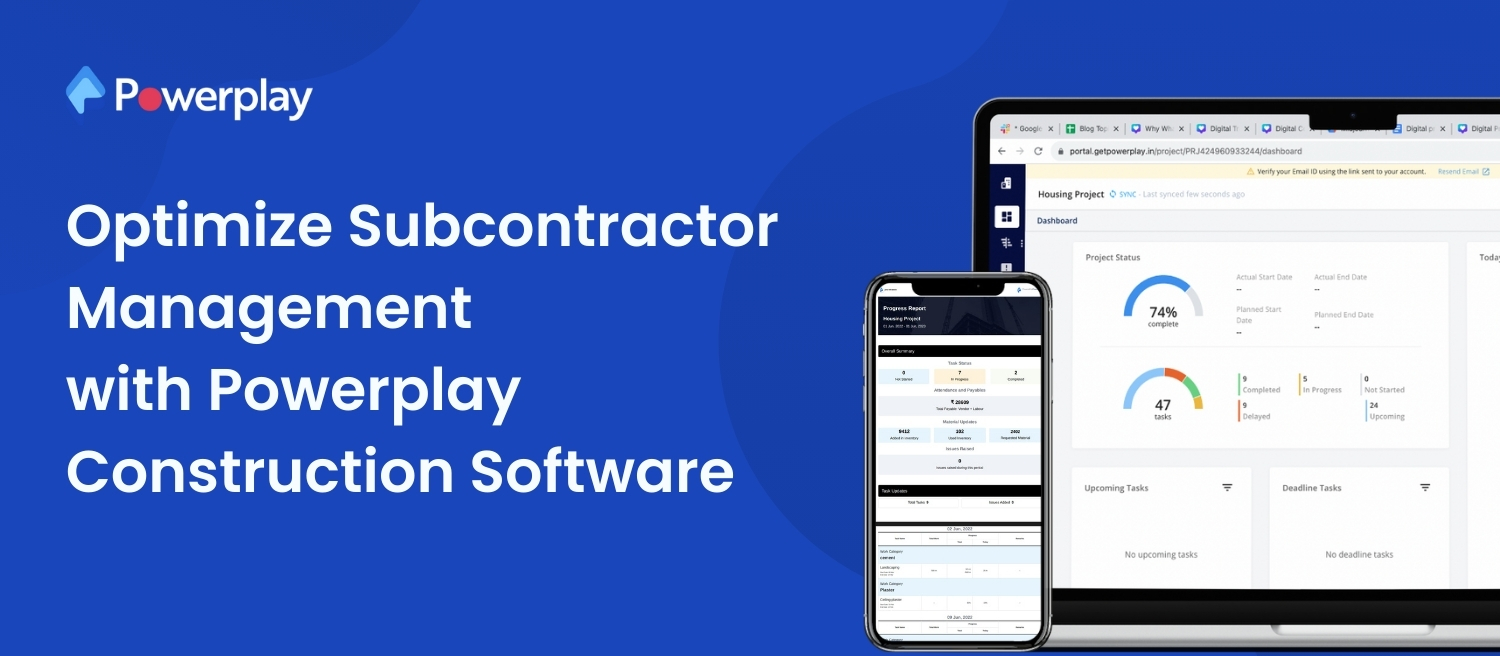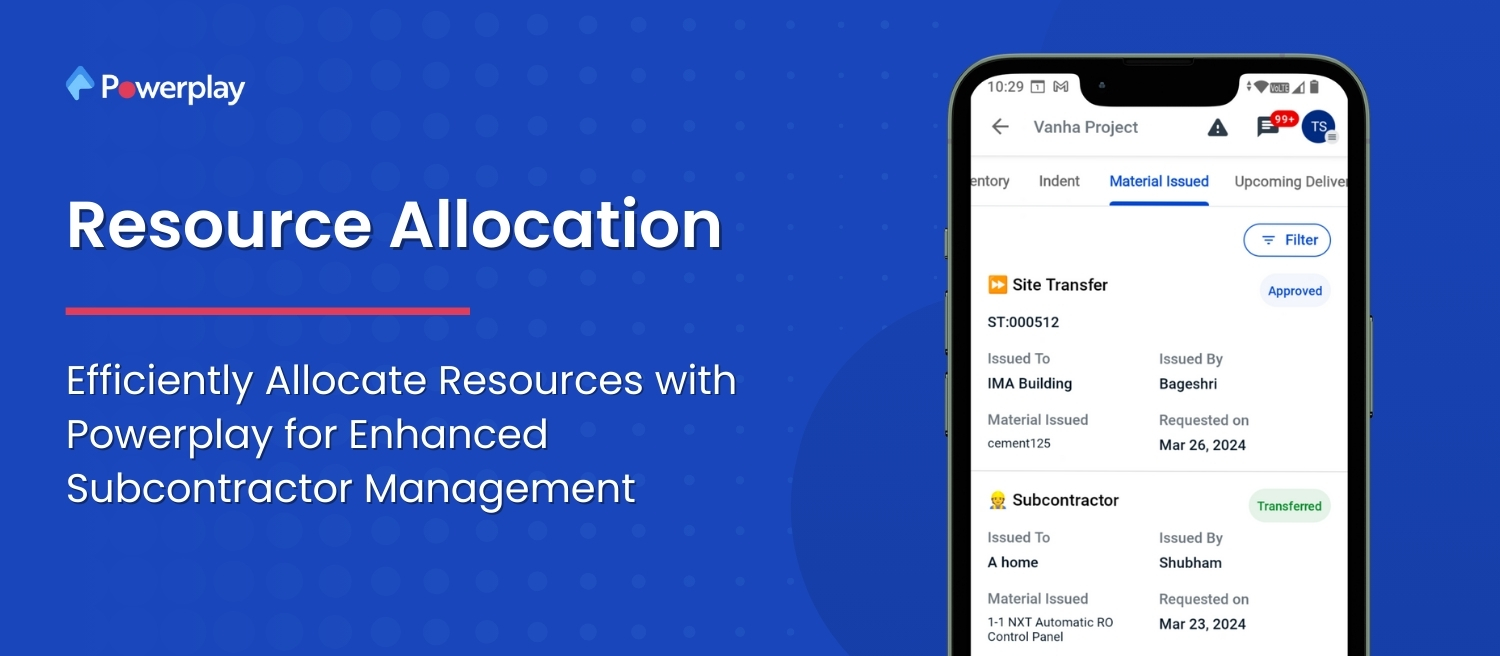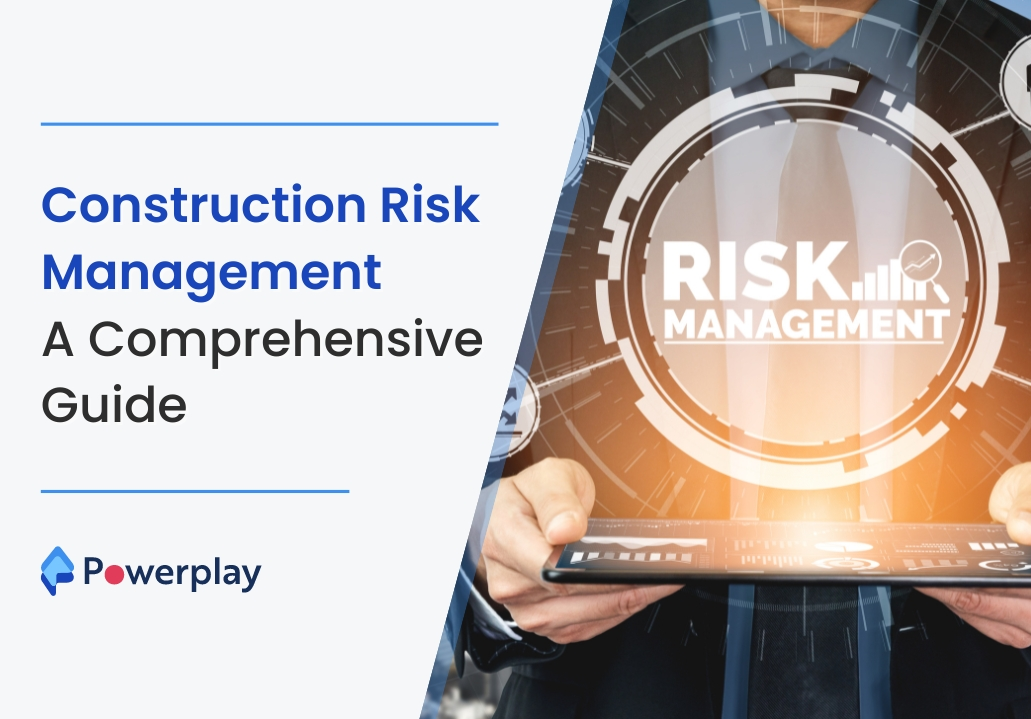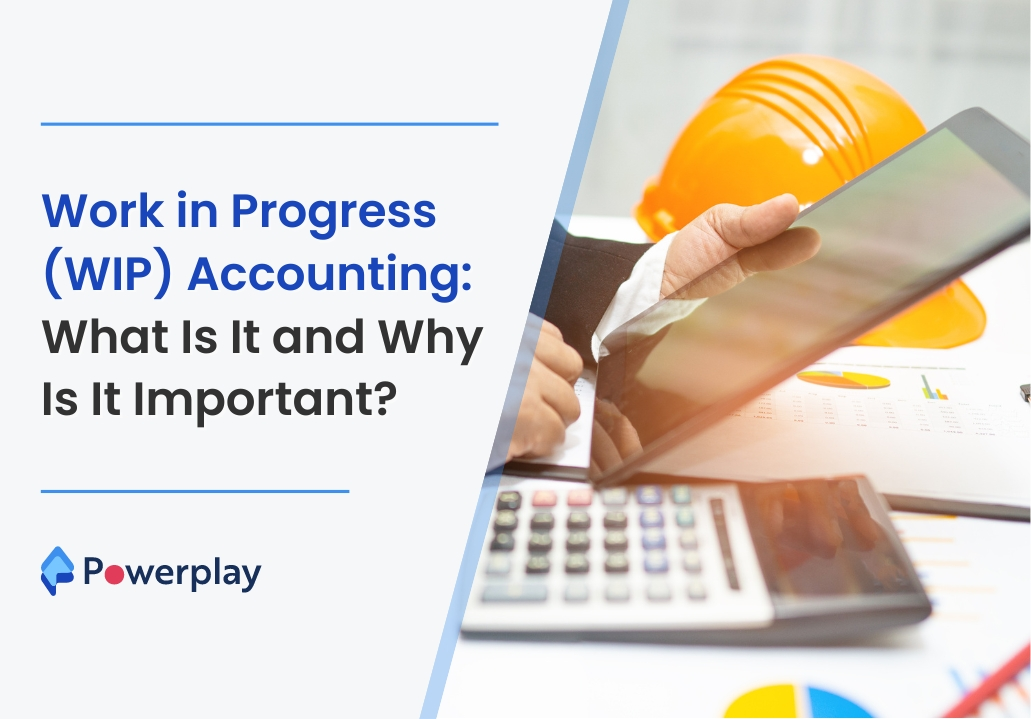9 Tips for Effective Subcontractor Management
-
Sapna
- May 7, 2024

Managing subcontractors effectively is important for the success of any project, and a well-established subcontractor relationship not only ensures projects are completed on time and within budget but also maintains quality standards and strengthens industry reputations. However, navigating these relationships can be challenging due to the complexities of differing work practices, schedules, and expectations. So, in this blog, we’ll explore best practices and tips for effective subcontractor management.

Table of Contents
ToggleWhat Is Subcontracting In Construction?
Construction subcontracting refers to hiring another company or individual (the subcontractor) to perform specific tasks or services within a larger construction project. These tasks include anything from electrical work and plumbing to painting and landscaping.
The main contractor typically hires the subcontractor, who oversees the entire project. Subcontracting allows for specialised expertise to be brought in for certain aspects of the project, it often results in high quality work and increased efficiency. It also enables the main contractor to focus on managing the overall project and coordinating various subcontractors.
What Is a Subcontractor?

A subcontractor is an independent professional engaged on a project-specific basis, primarily within the construction industry, to contribute specialised skills or services. Unlike employees, subcontractors typically work for themselves or their small businesses. They are sought after for their expertise in particular trades or tasks, such as electrical wiring, carpentry, or concrete work.
Since subcontractors are not permanently affiliated with any single employer, they can choose which projects to undertake. This flexibility, however, can pose challenges in finding consistent work, leading many subcontractors to seek partnerships with general contractors who manage larger construction projects.
Types of Construction Subcontractors

Construction subcontractors encompass a wide range of specialised roles within the industry. Some common types of construction subcontractors include:
- Electrical Subcontractors: These specialists handle the installation, maintenance, and repair of electrical systems within buildings, including wiring, fixtures, and electrical panels.
- Plumbing Subcontractors: Plumbing subcontractors are responsible looking after the installing, repairing, and maintaining plumbing systems, which can also include pipes, fixtures, and fittings, to ensure proper water distribution and waste removal in buildings.
- HVAC (Heating, Ventilation, and Air Conditioning) Subcontractors: HVAC subcontractors focus on installing, repairing, and maintaining heating, cooling, and ventilation systems to regulate indoor temperature, humidity, and air quality in buildings.
- Carpentry Subcontractors: Carpenters specialise in various woodworking tasks, including framing, installing doors and windows, building stairs, and finishing work such as trim and moulding.
- Concrete Subcontractors: Concrete subcontractors pour, finish, and repair concrete structures like foundations, slabs, walls, and sidewalks, using various techniques and materials to ensure structural integrity and durability.
Why Subcontracting in the Building Sector?
Subcontracting in the building sector is common due to the specialised nature of construction tasks. Building projects require diverse skills, from electrical and plumbing work to carpentry and HVAC installation. Subcontractors bring specialised expertise to these areas, ensuring high-quality results.
This division of labour enhances project efficiency and allows main contractors to focus on project management. Additionally, subcontracting offers cost savings by reducing overhead expenses associated with full-time employees. It provides flexibility in staffing, enabling construction companies to scale their workforce as needed. Overall, subcontracting mitigates risk, ensures compliance with regulations, and contributes to completing building projects.
General Contractor vs. Subcontractor

General Contractor (GC)
- Role: A general contractor is responsible for overseeing the entire construction project. It involes managing all aspects of the project from start to finish—hiring subcontractors, procuring materials, ensuring compliance with building codes, and communicating with the client.
- Authority: They have overall project authority and are the client’s main point of contact.
- Responsibility: GCs are liable for completing the project as specified in the contract, including the quality of work, timelines, and budget management.
Subcontractor
- Role: Subcontractors are specialised professionals hired by the general contractor to perform specific parts of the construction work, such as plumbing, electrical, HVAC, or roofing.
- Authority: They report to the general contractor without directly interacting with the client regarding contract negotiations.
- Responsibility: Their responsibility is limited to their speciality area. They focus on executing their portion of the project effectively and according to the specifications laid out by the general contractor.
Independent Contractor vs. Subcontractor
Independent Contractor
- Role: An independent contractor can be any self-employed professional hired to complete specific tasks. They could be architects, designers, or specialised workers similar to subcontractors in construction.
- Contractual Relationship: Depending on the project’s needs, they need to have a direct contractual relationship with the client or the general contractor.
- Scope of Work: They are responsible for managing their work schedule and how they perform their work, and they typically provide their own tools and materials.
Subcontractor
- Role: As mentioned, subcontractors specialise in certain trades and are part of the construction project team.
- Contractual Relationship: They are usually hired and managed by the general contractor rather than the client.
- Scope of Work: Subcontractors focus on specific tasks assigned by the general contractor and are not involved in the broader project management or client interactions unless specified.
What is subcontractor management?
Subcontractor management refers to the process of overseeing and coordinating the activities of subcontractors to ensure they effectively contribute to the successful completion of a project. It involves selecting the right subcontractors, negotiating agreements, monitoring their performance, ensuring compliance with contractual obligations and safety regulations, resolving disputes, and maintaining open communication channels. Effective subcontractor management is crucial for maintaining project timelines, quality standards, and budget constraints.
Subcontractor Management Process:
The subcontractor management process involves several key steps:
- Identification and Selection: Identifying potential subcontractors with the required expertise, capabilities, and resources to fulfil project requirements.
- Prequalification: Evaluating subcontractors based on criteria such as past performance, financial stability, safety record, and adherence to regulations.
- Contract Negotiation involves negotiating terms and conditions, scope of work, pricing, deadlines, and other contractual agreements.
- Onboarding: Orienting subcontractors to project goals, safety protocols, quality standards, and expectations.
- Monitoring and Performance Evaluation: Regularly assessing subcontractor performance, progress, and compliance with contractual requirements.
- Issue Resolution involves addressing any issues or conflicts that arise during the project, such as delays, disputes, or quality concerns.
- Payment and Closure: Ensuring timely and accurate payment to subcontractors upon satisfactory completion of work and resolution of any outstanding issues.
Subcontractor Agreement:
A subcontractor agreement is a legal binding contract between a primary contractor and a subcontractor. It outlines the terms and conditions of their working relationship, including but not limited to:
- Scope of work: Clearly define the tasks, responsibilities, and deliverables assigned to the subcontractor.
- Compensation: Stipulating the payment terms, rates, invoicing procedures, and any additional costs or expenses.
- Duration: Mention the start and end date of the subcontractor’s involvement in the project.
- Performance standards: Establishing quality requirements, safety protocols, and compliance with relevant regulations.
- Termination clauses: These clauses outline the conditions under which either party can terminate the agreement, along with any associated penalties or liabilities.
Subcontractor Risk:

Subcontractor risk refers to the potential threats or uncertainties associated with involving subcontractors in a project. These risks can include:
- Performance Risks: Subcontractors may fail to meet project requirements, deadlines, or quality standards, leading to delays, rework, or compromised outcomes.
- Financial Risks: Subcontractors may experience financial difficulties, such as bankruptcy or insolvency, which could disrupt project continuity or result in financial losses.
- Legal Risks: Disputes over contractual obligations, intellectual property rights, liability issues, or non-compliance with regulations can lead to legal challenges and litigation.
- Reputational Risks: Poor performance or misconduct by subcontractors can tarnish the reputation of the primary contractor, affecting future business opportunities and client relationships.
- Safety Risks: Subcontractors may pose safety hazards or fail to adhere to safety protocols, increasing the risk of accidents, injuries, or regulatory violations.
Subcontractor management best practices
Effective subcontractor management is crucial for the success of construction projects. It ensures that work is completed on time, within allocated budget, and to the required quality standards. Here are some best practices.
Complete screening Process
Conduct thorough due diligence before hiring subcontractors. This includes checking their past project experiences, financial stability, reputation in the industry, and references. Ensure they have the necessary licenses and insurance to handle the job.
Clear Contracts
Draft clear and detailed contracts that outline every aspect of the project, which involves scope of work, timelines, payment schedules, and quality expectations. Clearly define clauses for delays, dispute resolution, and penalties for non-compliance.
Effective Communication
Establish regular communication channels and schedules. Use meetings, emails, and construction management software to keep everyone informed. Clarity in communication prevents misunderstandings and ensures that everyone is aligned with the project goals.
Onboarding and Training
Properly onboard subcontractors to familiarise them with the project specifics, your company’s policies, and safety protocols. If necessary, provide training to ensure their work meets the project’s standards.
Scheduled Inspections and Meetings
Regularly schedule inspections and progress meetings to monitor the quality of work and ensuring adherence to the timeline. This also provides an opportunity to address any issues or concerns that may arise.
Integration into the Project Team
Treat subcontractors as integral members of the project team. This fosters a collaborative environment where subcontractors are valued and are more likely to provide positively to the project.
Prompt Payments
Ensure timely payments as per contract terms. Prompt payments build trust and maintain a good working relationship, encouraging subcontractors to meet their commitments.
Use of Technology
Leverage technology such as project management software to streamline scheduling, documentation, and communication. Tools like Powerplay or CoConstruct can help manage multiple subcontractors efficiently.
Performance Evaluation
Implement a system for evaluating subcontractor performance based on key metrics such as timeliness, quality, and adherence to safety standards. Use these evaluations to provide feedback and decide on future engagements.
Tips for Easier Subcontractor Management

Managing subcontractors effectively is essential for smooth operations and project success. Here are nine tips to make subcontractor management easier:
Set Clear Expectations Early
Clearly articulate your expectations regarding project scope, timelines, and quality standards right from the start. This clarity helps prevent disputes and misunderstandings.
Empower with Responsibility
Grant subcontractors autonomy within defined project parameters. This will help in achiving higher job satisfaction and superior quality of work, as subcontractors feel more invested in the outcomes.
Regularly Update Project Goals
Consistently communicate any changes in project goals or timelines to ensure all parties are aligned. This keeps subcontractors informed and can help prevent scheduling conflicts.
Foster a Positive Work Environment
Ensure to Create and maintain a respectful and inclusive work environment. Recognising good work and providing constructive feedback can boost productivity and reduce turnover.
Have a Contingency Plan
Prepare for unexpected issues by having backup plans and resources ready. This could involve standby subcontractors or additional materials and equipment to handle unforeseen challenges.
Use Technology for Better Coordination
Implement project management software to streamline communication, scheduling, and documentation. Tools like Procore or CoConstruct can help manage tasks and timelines more effectively.
Conduct Regular Meetings
Hold regular meetings with subcontractors to discuss progress, challenges, and feedback. These meetings can foster a sense of collaboration and prompt resolution of potential issues.
Implement a Structured Feedback Process
Establish a system for ongoing feedback, both formal and informal. It helps to identify areas of improvement and allows subcontractors to adjust their methods or approaches promptly.
Ensure Timely Payments
Pay subcontractors on time according to agreed terms. Timely payments are crucial for maintaining a trustworthy relationship and ensuring subcontractors are motivated to meet project demands.
How Powerplay can help in subcontractor management?
Powerplay, as a construction project management software, offers a various of features designed to streamline and enhance the management of subcontractors. These tools facilitate better communication, coordination, and tracking, ensuring that subcontractors deliver high-quality work on time and within budget.

Here are some key features of Powerplay that can help in subcontractor management:
Communication:
Powerplay provides integrated communication tools that enable real-time updates and messaging between the project manager, subcontractors, and other stakeholders. This ensures everyone is on the same page and can address issues promptly.

Task Scheduling:

Powerplay offers features which allows managers to assign tasks to specific subcontractors and set deadlines. Subcontractors can access their tasks, see detailed requirements, and update their progress, which helps keep the project on schedule.

Powerplay supports centralised document management, where contracts, plans, specifications, and compliance documents can be stored and shared. Subcontractors can easily access the documents they need, ensuring they work according to the latest specifications.
Resource Allocation:

With Powerplay, project managers can efficiently allocate resources, ensuring that subcontractors have what they need when they need it. This minimises downtime and increases productivity.
Financial Management:

Powerplay offers features for tracking budgets, invoices, and payments. This helps in maintaining financial control over subcontractor expenses, ensuring timely payments, and managing contract terms effectively.
Conclusion
Effective subcontractor management is important to the success of construction projects. It not only ensures that projects meet their deadlines, budgets, and quality standards, but it also fortifies relationships within the industry and enhances overall reputational strength. By adopting best practices and tips and by harnessing software like Powerplay for seamless coordination and to monitoring, project managers can navigate the complexities of subcontractor relationships with greater ease. Ultimately, the aim is to create a collaborative environment that maximises efficiency and output, laying a solid foundation for the successful completion of every project.












